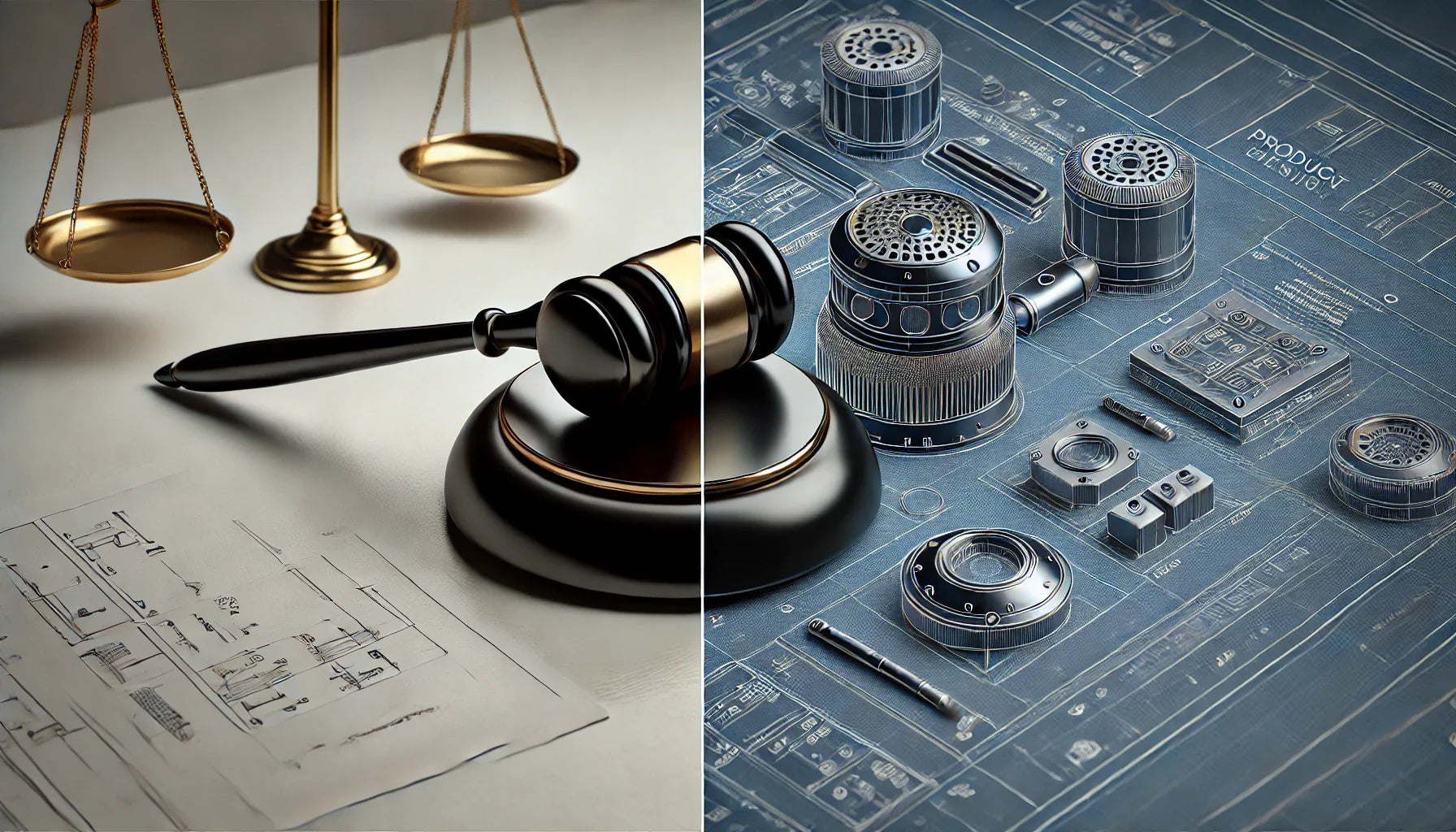Quick Overview
Learn how to create competitive products without crossing the line into intellectual property infringement. This guide explains how to navigate patents, trademarks, and copyrights, empowering businesses to innovate responsibly while avoiding legal pitfalls.

Common Questions & Answers
-
Can I legally replicate parts of a product?
Yes, but only if those parts aren’t protected by patents, trademarks, or copyrights. Conduct a thorough IP search first. -
What’s the difference between inspiration and infringement?
Inspiration involves creating something new and unique. Infringement copies protected elements directly. -
Are design patents a concern?
Absolutely! Any unique ornamental design is protected, so avoid duplicating such features. -
Can I reverse-engineer a product?
Yes, but be cautious. Reverse engineering is legal if you don’t violate trade secrets or patented technology. -
What are the consequences of IP infringement?
They include lawsuits, damages, and possibly an injunction to stop selling your product.

Step-by-Step Guide
- Conduct an IP Audit: Search for patents, trademarks, and copyrights associated with the product.
- Find the Legal Gray Areas: Focus on features not covered by IP laws—like unprotected functional elements.
- Redesign Creatively: Add unique features and branding to differentiate your product.
- Consult with Legal Experts: Have an attorney review your design to ensure compliance.
- Test the Market Carefully: Launch with a clear understanding of your competitors' legal boundaries.
Historical Context
Imitation has been a part of commerce for centuries. From early luxury goods to modern tech, companies have sought to replicate success stories. However, legal frameworks like patents (dating back to 15th-century Venice), trademarks (formalized in 19th-century England), and copyright (codified in the Statute of Anne in 1710) emerged to protect innovators. Balancing innovation and legal boundaries is the crux of modern product development.

Business Competition Examples
-
Samsung vs. Apple
Samsung redesigned products to avoid infringing on Apple's design patents, resulting in competitive yet unique devices. -
Generic Pharma Industry
Companies legally replicate name-brand drugs after patents expire, ensuring accessibility while complying with IP laws. -
Fast Fashion Giants
Brands like Zara recreate high-fashion designs by focusing on unprotected aspects like material choices and functionality. -
3D Printing Market
Innovators create customizable designs while respecting IP protections of existing products.

Discussion
The Fine Line Between Imitation and Innovation
Navigating the intersection of competition and creativity is one of the greatest challenges for modern businesses. While some view imitation as a shortcut to success, others argue it is the foundation of innovation. After all, some of the world’s most successful products were born from existing ideas that were refined, reimagined, and reinvented. But where should businesses draw the line?
Understanding the Legal Framework
First, let’s explore what constitutes infringement. Intellectual property laws are designed to protect the unique aspects of a product, including its design, functionality, and branding. Patents cover inventions and processes, copyrights shield creative works, and trademarks protect brand identity elements. Violating these protections can lead to legal disputes that damage a company’s reputation and finances.
However, IP laws also leave room for innovation. Functional aspects of a product—like the way it performs a task—cannot be patented if they are common knowledge or not novel. This provides an opportunity for companies to create alternative solutions without crossing into infringement territory.

Balancing Ethical and Financial Considerations
Ethics also play a role. While it’s tempting to mimic a market leader to cut costs and gain a competitive edge, doing so can backfire. Consumers increasingly value originality and authenticity, and being perceived as a copycat brand can erode trust. Successful businesses focus on improving upon existing ideas or solving problems the original product didn’t address.
The challenge is investing in differentiation while maintaining cost efficiency. Companies must ask themselves: are they truly adding value, or merely riding on someone else’s coattails?
Practical Steps to Innovate Responsibly
To stay on the right side of the law and consumer sentiment, businesses should focus on these three principles:
- Thorough Research: Understand what aspects of the product are protected and what is fair game for adaptation.
- Creative Redesign: Go beyond replication. Think about how to improve or alter the product to stand out.
- Collaboration with Legal Experts: Regular consultations with IP attorneys can prevent costly mistakes before they happen.

The Role of Reverse Engineering
Reverse engineering is a legal and often ethical way to innovate, provided it doesn’t involve breaking trade secret laws. It allows companies to dissect existing products, understand their mechanics, and use that knowledge to build something new. However, transparency is key—reverse-engineering practices must comply with local laws and industry norms to avoid accusations of wrongdoing.
Moving Toward Sustainable Innovation
Ultimately, the goal is to innovate in a way that benefits not just the company but also the market and its consumers. This involves creating products that are not only legal but also ethical and meaningful. By emphasizing originality and respecting intellectual property laws, businesses can foster a culture of sustainable innovation that drives long-term success.

The Debate
-
Pro-Copycat Argument:
Competition drives innovation and affordability. Alternative products often provide consumers with more choices at lower prices, creating a win-win situation. -
Anti-Copycat Argument:
Copying undermines innovation, discouraging inventors and creators from investing time and resources into new ideas.

Takeaways
- Always conduct thorough IP research before launching a product.
- Differentiate your product creatively to avoid legal risks.
- Understand the ethical implications of your business decisions.
- Consult experts to navigate the complexities of IP laws.
- Respect competitors' rights while building your unique brand identity.
Potential Business Hazards
- Inadvertent Infringement: Misjudging IP boundaries can lead to lawsuits.
- Reputation Damage: Being labeled a “knockoff” brand can harm customer trust.
- Market Ban: Courts may halt sales of infringing products, leading to revenue losses.
- High Legal Costs: Defending against infringement claims can drain resources.

Myths and Misconceptions
-
“If it’s not patented, I can copy it.”
False. Trademarks and copyrights might still apply. -
“Reverse engineering is always legal.”
Not if it involves violating trade secrets. -
“Small businesses won’t face lawsuits.”
Even startups can be targeted for IP infringement. -
“Changing 10% of the product makes it legal.”
IP law doesn’t operate on percentages—protection is about uniqueness.

Book & Podcast Recommendations
- Book: Patent It Yourself by David Pressman – A practical guide for inventors and entrepreneurs.
- Podcast: IP Fridays – A series about navigating intellectual property law.
- Book: The Innovator’s Dilemma by Clayton M. Christensen – Insights on market competition and innovation.
- Podcast: The Business of IP – Expert discussions on protecting and leveraging intellectual property.
Legal Cases
-
Apple Inc. v. Samsung Electronics Co.
- Summary: Landmark case on smartphone design patents.
- Relevance: Highlights the importance of design differentiation.
-
Keurig Green Mountain Inc. v. Touch Coffee & Beverages LLC
- Summary: Patent infringement in coffee maker designs.
- Relevance: Reinforces how even subtle design aspects can be protected.

Share Your Expertise
Explore resources at Miller IP’s Inventive Unicorn to stay ahead in product innovation and legal compliance.
Wrap Up
Innovation and imitation walk a fine line. By respecting intellectual property and focusing on differentiation, businesses can thrive while staying ethically and legally sound.













